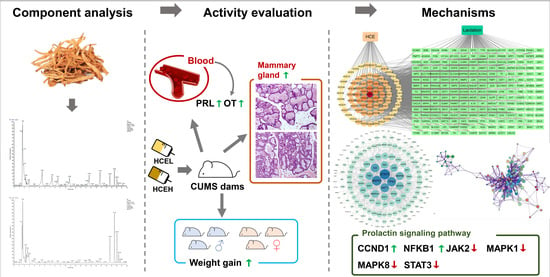Study and Experimental Validation of the Functional Components and Mechanisms of Hemerocallis citrina Baroni in the Treatment of Lactation Deficiency
Abstract
:1. Introduction
2. Materials and Methods
2.1. Chemicals and Reagents
2.2. Preparation of HCE Extracts
2.3. Chromatography and MS
2.4. Experiments Performed with Animals
2.5. Stress Procedure
2.6. Sample Collection
2.7. Evaluation of Lactation Promoting Activity
2.7.1. Weight Changes of Pups
2.7.2. Biochemical Analyses
2.7.3. Histopathological Analysis
2.8. Analysis of Potential Mechanism
2.8.1. Screening Targets of HCE–Lactation
2.8.2. PPI Network Construction
2.8.3. KEGG Enrichment Analysis
2.9. Total RNA Extraction and Real Time PCR
2.10. Statistical Analysis
3. Results
3.1. Identification of the Components in HCE Based on UPLC-Q-Orbitrap-MS and OTCML
3.2. Effects of HCE on Lactation of CUMS Dams
3.2.1. Pups Weight Change
3.2.2. Serum PRL and OT Level
3.2.3. Mammary Gland Tissue of Dams
3.3. Analysis and Validation of Potential Therapeutic Mechanism of HCE
3.3.1. Potential Target Screening of HCE by Network Pharmacology
3.3.2. Construction of “HCE-Targets-Lactation” Network
3.3.3. PPI Network of HCE-Lactation
3.3.4. KEGG Enrichment Analysis
3.3.5. Gene Expression of Prolactin Signaling Pathway
4. Discussion
5. Conclusions
Supplementary Materials
Author Contributions
Funding
Institutional Review Board Statement
Informed Consent Statement
Data Availability Statement
Acknowledgments
Conflicts of Interest
References
- Cohen, S.S.; Alexander, D.D.; Krebs, N.F.; Young, B.E.; Cabana, M.D.; Erdmann, P.; Hays, N.P.; Bezold, C.P.; Levin-Sparenberg, E.; Turini, M.; et al. Factors Associated with Breastfeeding Initiation and Continuation: A Meta-Analysis. J. Pediatr. 2018, 203, 190–196.e21. [Google Scholar] [CrossRef] [Green Version]
- Infant and Young Child Feeding. Available online: https://www.who.int/news-room/fact-sheets/detail/infant-and-young-child (accessed on 24 August 2020).
- Figueiredo, B.; Canário, C.; Field, T. Breastfeeding is negatively affected by prenatal depression and reduces postpartum depression. Psychol. Med. 2014, 44, 927–936. [Google Scholar] [CrossRef] [Green Version]
- Hahn-Holbrook, J.; Health, M.G. Does breastfeeding offer protection against maternal depressive symptomatology? A prospective study from pregnancy to 2 years after birth. Arch. Womens Ment. Health 2013, 16, 411–422. [Google Scholar] [CrossRef] [PubMed] [Green Version]
- Amini-Khoei, H.; Mohammadi-Asl, A.; Amiri, S.; Hosseini, M.J.; Momeny, M.; Hassanipour, M.; Rastegar, M.; Haj-Mirzaian, A.; Mirzaian, A.H.; Sanjarimoghaddam, H.; et al. Oxytocin mitigated the depressive-like behaviors of maternal separation stress through modulating mitochondrial function and neuroinflammation. Prog. Neuropsychopharmacol. Biol. Psychiatry 2017, 76, 169–178. [Google Scholar] [CrossRef] [PubMed]
- Figueiredo-Braga, M.; Moura, D.; Canavarro, M.C. Oxytocin and depression in the perinatal period-a systematic review. Arch. Womens Ment. Health 2016, 19, 561–570. [Google Scholar]
- Lara-Cinisomo, S.; McKenney, K.; Di Florio, A.; Meltzer-Brody, S. Associations between Postpartum Depression, Breastfeeding, and Oxytocin Levels in Latina Mothers. Breastfeed. Med. 2017, 12, 436–442. [Google Scholar] [CrossRef] [PubMed]
- Grzeskowiak, L.E.; Wlodek, M.E.; Geddes, D.T. What Evidence Do We Have for Pharmaceutical Galactagogues in theTreatment of Lactation Insufficiency?-A Narrative Review. Nutrients 2019, 11, 974. [Google Scholar] [CrossRef] [PubMed] [Green Version]
- Druilhe, P.; Brandicourt, O.; Chongsuphajaisiddhi, T.; Berthe, J. Activity of a combination of three cinchona bark alkaloids against Plasmodium falciparum in vitro. Antimicrob. Agents Chemother. 1988, 32, 250–254. [Google Scholar] [CrossRef] [Green Version]
- Wagner, H.; Ulrich-Merzenich, G. Synergy research: Approaching a new generation of phytopharmaceuticals. Phytomedicine 2009, 16, 97–110. [Google Scholar] [CrossRef]
- Lewicka, A.; Szymański, Ł.; Rusiecka, K.; Kucza, A.; Jakubczyk, A.; Zdanowski, R.; Lewicki, S. Supplementation of Plants with Immunomodulatory Properties during Pregnancy and Lactation-Maternal and Offspring Health Effects. Nutrients 2019, 11, 1958. [Google Scholar] [CrossRef] [Green Version]
- Lin, Y.L.; Lu, C.K.; Huang, Y.J.; Chen, H.J. Antioxidative caffeoylquinic acids and flavonoids from Hemerocallis fulva flowers. J. Agric. Food Chem. 2011, 59, 8789–8795. [Google Scholar] [CrossRef]
- Bloomer, R.J.; MacDonnchadh, J.J.; Moran, R.G.; Timmcke, J.Q.; Qin, B. Impact of a dietary supplement containing rosemary and daylily on biochemical markers of cognitive health, sleep quality and related variables in men and women. Health 2016, 8, 1307–1322. [Google Scholar] [CrossRef] [Green Version]
- Yi, L.T.; Li, J.; Li, H.C.; Zhou, Y.; Su, B.F.; Yang, K.F.; Jiang, M.; Zhang, Y.T. Ethanol extracts from Hemerocallis citrina attenuate the decreases of brain-derived neurotrophic factor, TrkB levels in rat induced by corticosterone administration. J. Ethnopharmacol. 2012, 144, 328–334. [Google Scholar] [CrossRef]
- Gu, L.; Liu, Y.J.; Wang, Y.B.; Yi, L.T. Role for monoaminergic systems in the antidepressant-like effect of ethanol extracts from Hemerocallis citrina. J. Ethnopharmacol. 2012, 139, 780–787. [Google Scholar] [CrossRef]
- Chen, G.Z.; Zhang, C.X.; Fan, Y.S.; Chen, J.B. Treatment of 156 cases of depression related insomnia by Hemerocallis citrina. Zhejiang J. Tradit. Chin. Med. 2008, 43, 397. [Google Scholar]
- Du, B.; Tang, X.; Liu, F.; Zhang, C.; Zhao, G.; Ren, F.; Leng, X. Antidepressant-like effects of the hydroalcoholic extracts of Hemerocallis citrina and its potential active components. BMC Complement. Altern. Med. 2014, 14, 326. [Google Scholar] [CrossRef] [Green Version]
- Lin, S.H.; Chang, H.C.; Chen, P.J.; Hsieh, C.L.; Su, K.P.; Sheen, L.Y. The antidepressant-like effect of ethanol extract of daylily flowers (Jīn Zhēn Huā) in rats. eJTCM 2013, 3, 53–61. [Google Scholar]
- Liu, X.L.; Luo, L.; Liu, B.B.; Li, J.; Geng, D.; Liu, Q.; Yi, L.T. Ethanol extracts from Hemerocallis citrina attenuate the upregulation of proinflammatory cytokines and indoleamine 2,3-dioxygenase in rats. J. Ethnopharmacol. 2014, 153, 484–490. [Google Scholar] [CrossRef]
- Tang, D.B.; Xia, Y.B.; Zhang, B.; Peng, G.P. Huang hua cai de shi yong jia zhi ji kai fa li yong [Edible value and exploitation of Hemerocallis citrina Baroni]. Food Nutr. China 2003, 8, 23–24. [Google Scholar]
- Lu, S.H. Chan hou wu ru huo shao ru de yin shi liao fa [Diet therapy of postpartum no milk or less milk]. China’s Naturop. 2011, 19, 66. [Google Scholar]
- Zhao, P.Z.; Qiu, K.F. Cui ru gong neng xing shi pin de gong xiao yan jiu [Study on the efficacy of milk—Stimulating functional food]. Chin. Wild Plant Resour. 1995, 4, 10–11. [Google Scholar]
- Roth, B.L.; Sheffler, D.J.; Kroeze, W.K. Magic shotguns versus magic bullets: Selectively non-selective drugs for mood disorders and schizophrenia. Nat. Rev. Drug Discov. 2004, 3, 353–359. [Google Scholar] [CrossRef] [Green Version]
- Hopkins, A.L. Network pharmacology. Nat. Biotechnol. 2007, 25, 1110–1111. [Google Scholar] [CrossRef] [PubMed]
- Lv, X.; Xu, Z.; Xu, G.; Li, H.; Wang, C.; Chen, J.; Sun, J. Investigation of the active components and mechanisms of Schisandra chinensis in the treatment of asthma based on a network pharmacology approach and experimental validation. Food Funct. 2020, 11, 3032–3042. [Google Scholar] [CrossRef]
- Tu, C.; Niu, M.; Li, C.; Liu, Z.; He, Q.; Li, R.; Zhang, Y.; Xiao, X.; Wang, J. Network pharmacology oriented study reveals inflammatory state-dependent dietary supplement hepatotoxicity responses in normal and diseased rats. Food Funct. 2019, 10, 3477–3490. [Google Scholar] [CrossRef]
- Zhang, C.; Wang, N.; Xu, Y.; Tan, H.Y.; Li, S.; Feng, Y. Molecular mechanisms involved in oxidative stress-associated liver injury induced by Chinese herbal medicine: An experimental evidence-based literature review and network pharmacology study. Int. J. Mol. Sci. 2018, 19, 2745. [Google Scholar] [CrossRef] [Green Version]
- Sun, J.; Liu, W.; Zhang, M.; Geng, P.; Shan, Y.; Li, G.; Zhao, Y.; Chen, P. The analysis of phenolic compounds in daylily using UHPLC-HRMSnand evaluation of drying processing method by fingerprinting and metabolomic approaches. J. Food Process. Preserv. 2018, 42, e13325. [Google Scholar] [CrossRef]
- Yuxuan, L.; Riming, H.; Yongchun, C.; Jing, Z.; Jie, D.; Ziyi, W.; Zhuojun, W.; Meiying, L.; Hong, W.; Yuanming, S. Study on the sleep-improvement effects of Hemerocallis citrina Baroni in Drosophila melanogaster and targeted screening to identify its active components and mechanism. Foods 2021, 10, 883. [Google Scholar]
- Leuner, B.; Fredericks, P.J.; Nealer, C.; Albin-Brooks, C. Chronic gestational stress leads to depressive-like behavior and compromises medial prefrontal cortex structure and function during the postpartum period. PLoS ONE 2014, 9, e89912. [Google Scholar] [CrossRef] [PubMed] [Green Version]
- Lin, M.; Wang, N.; Yao, B.; Zhong, Y.; Lin, Y.; You, T. Quercetin improves postpartum hypogalactia in milk-deficient mice via stimulating prolactin production in pituitary gland. Phytother. Res. 2018, 32, 1511–1520. [Google Scholar] [CrossRef]
- Xudong, G.; Qiyu, D.; Yueying, W.; Yan, T.; Guilong, Y.; Xinjian, W. Effect of dietary rutin on mammary gland development and the level and receptors of estrogen in lactation rats. Zhongguo Nongye Daxue Xuebao 2011, 16, 88–95. [Google Scholar]
- Rossini, A.; Zanobbio, L.; Palazzo, M.; Sfondrini, L.; Morelli, D.; Tagliabue, E.; Balsari, A.; Rumio, C. Influence of Lignans Depletion on Murine Mammary Gland Morphology. Nutr. Cancer 2010, 62, 237–242. [Google Scholar] [CrossRef]
- Collier, R.J.; Hernandez, L.L.; Horseman, N.D. Serotonin as a homeostatic regulator of lactation. Domest. Anim. Endocrinol. 2012, 43, 161–170. [Google Scholar] [CrossRef]
- Pan, X.; Liu, X.; Zhao, H.; Wu, B.; Liu, G. Antioxidant, anti-inflammatory and neuroprotective effect of kaempferol on rotenone-induced Parkinson’s disease model of rats and SH-S5Y5 cells by preventing loss of tyrosine hydroxylase. J. Funct. Foods 2020, 74, 104140. [Google Scholar] [CrossRef]
- Grzelczyk, J.; Budryn, G.; Pea-García, J.; Szwajgier, D. Evaluation of the inhibition of monoamine oxidase A by bioactive coffee compounds protecting serotonin degradation. Food Chem. 2021, 348, 129108. [Google Scholar] [CrossRef] [PubMed]
- Tanveer, S.; Taranjot, K.; Rajesh, K.G. Adjuvant quercetin therapy for combined treatment of epilepsy and comorbid depression. Neurochem. Int. 2017, 104, 27–33. [Google Scholar]
- Bionaz, M.; Loor, J.J. Gene networks driving bovine mammary protein synthesis during the lactation cycle. Bioinform. Biol. Insights 2011, 5, 83–98. [Google Scholar] [CrossRef]
- Osorio, J.S.; Lohakare, J.; Bionaz, M. Biosynthesis of milk fat, protein, and lactose: Roles of transcriptional and posttranscriptional regulation. Physiol. Genom. 2016, 48, 231–256. [Google Scholar] [CrossRef] [Green Version]
- Truchet, S.; Honvo-Houeto, E. Physiology of milk secretion. Best Pr. Res. Clin. Endocrinol. Metab. 2017, 31, 367–384. [Google Scholar] [CrossRef] [PubMed]
- Jena, M.K.; Jaswal, S.; Kumar, S.; Mohanty, A.K. Molecular mechanism of mammary gland involution: An update. Dev. Biol. 2019, 445, 145–155. [Google Scholar] [CrossRef]
- Asher, J.M.; O’Leary, K.A.; Rugowski, D.E.; Arendt, L.M.; Schuler, L.A. Prolactin promotes mammary pathogenesis independently from Cyclin D1. Am. J. Pathol. 2012, 181, 294–302. [Google Scholar] [CrossRef] [PubMed] [Green Version]
- Slepicka, P.F.; Somasundara, A.V.H.; Dos Santos, C.O. The molecular basis of mammary gland development and epithelial differentiation. Semin. Cell Dev. Biol. 2021, 114, 93–112. [Google Scholar] [CrossRef]
- Basu, A.; Das, A.S.; Sharma, M.; Pathak, M.P.; Chattopadhyay, P.; Biswas, K.; Mukhopadhyay, R. STAT3 and NF-κB are common targets for kaempferol-mediated attenuation of COX-2 expression in IL-6-induced macrophages and carrageenan-induced mouse paw edema. Biochem. Biophys. Rep. 2017, 26, 54–61. [Google Scholar] [CrossRef]
- Hennighausen, L.; Robinson, G.W.; Wagner, K.U.; Liu, W. Prolactin signaling in mammary gland development. J. Biol. Chem. 1997, 272, 7567–7569. [Google Scholar] [CrossRef] [Green Version]
- Fantl, V.; Stamp, G.; Andrews, A.; Rosewell, I.; Dickson, C. Mice lacking cyclin D1 are small and show defects in eye and mammary gland development. Genes Dev. 1995, 9, 2364–2372. [Google Scholar] [CrossRef] [Green Version]
- Shillingford, J.M.; Miyoshi, K.; Robinson, G.W.; Bierie, B.; Cao, Y.; Karin, M.; Hennighausen, L. Proteotyping of mammary tissue from transgenic and gene knockout mice with immunohistochemical markers: A tool to define developmental lesions. J. Histochem. Cytochem. 2003, 51, 555–565. [Google Scholar] [CrossRef] [PubMed] [Green Version]
- Lee, J.Y.; Lim, W.; Ryu, S.; Kim, J.; Song, G. Ochratoxin A mediates cytotoxicity through the MAPK signaling pathway and alters intracellular homeostasis in bovine mammary epithelial cells. Environ. Pollut. 2019, 246, 366–373. [Google Scholar] [CrossRef]
- Anderson, S.M.; Rudolph, M.C.; McManaman, J.L.; Neville, M.C. Key stages in mammary gland development. Secretory activation in the mammary gland: It’s not just about milk protein synthesis! Breast Cancer Res. 2007, 9, 204. [Google Scholar] [CrossRef]
- Zhao, L.; Hart, S.; Cheng, J.; Melenhorst, J.J.; Bierie, B.; Ernst, M.; Stewart, C.; Schaper, F.; Heinrich, P.C.; Ullrich, A.; et al. Mammary gland remodeling depends on gp130 signaling through Stat3 and MAPK. J. Biol. Chem. 2004, 279, 44093–44100. [Google Scholar] [CrossRef] [Green Version]
- Brantley, D.M.; Yull, F.E.; Muraoka, R.S.; Hicks, D.J.; Cook, C.M.; Kerr, L.D. Dynamic expression and activity of NF-kappaB during post-natal mammary gland morphogenesis. J. Mech. Dev. 2000, 97, 149–155. [Google Scholar] [CrossRef]
- Cao, Y.; Karin, M. NF-κB in Mammary Gland Development and Breast Cancer. J. Mammary Gland Biol. Neoplasia 2003, 8, 215–223. [Google Scholar] [CrossRef] [PubMed]
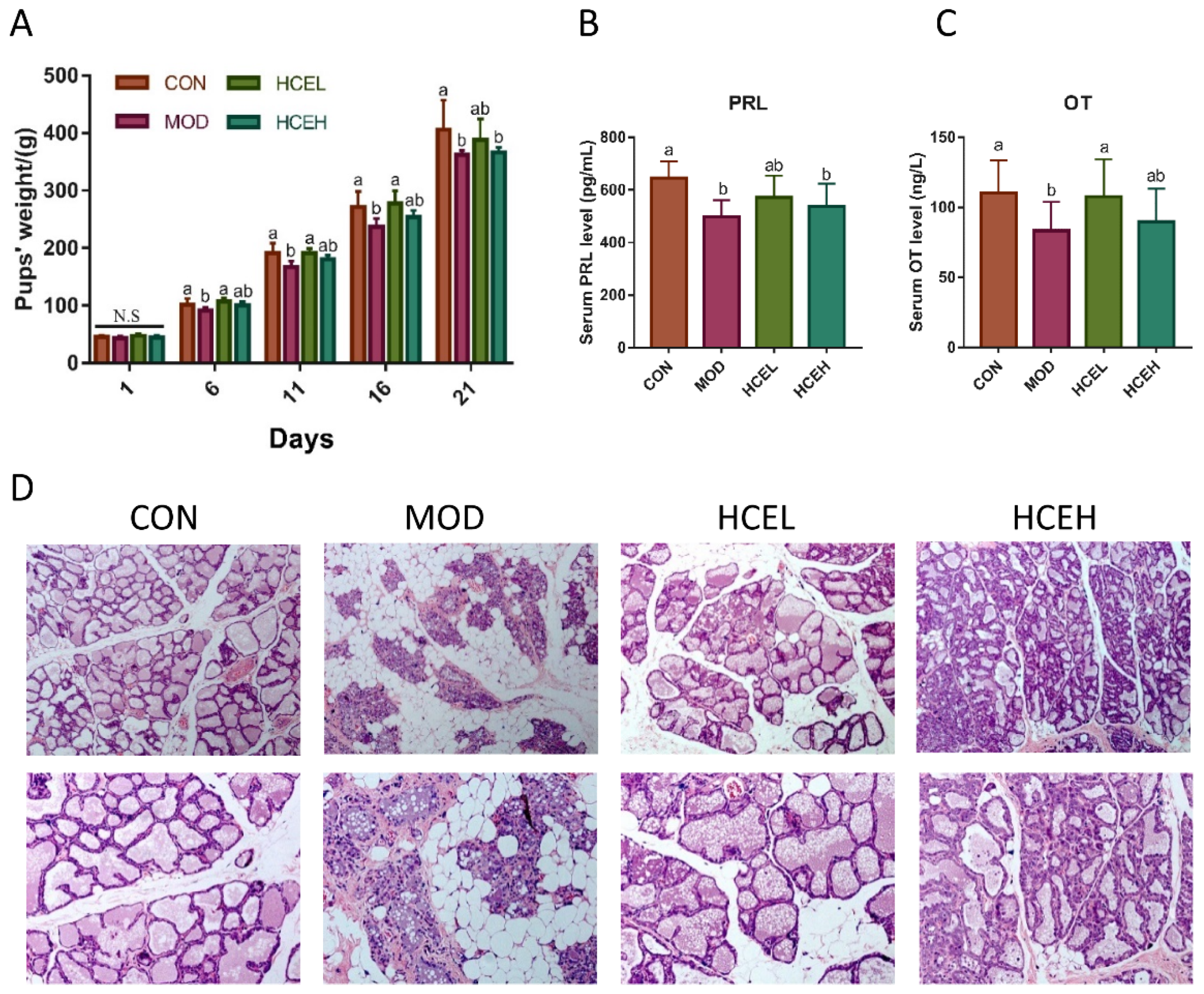
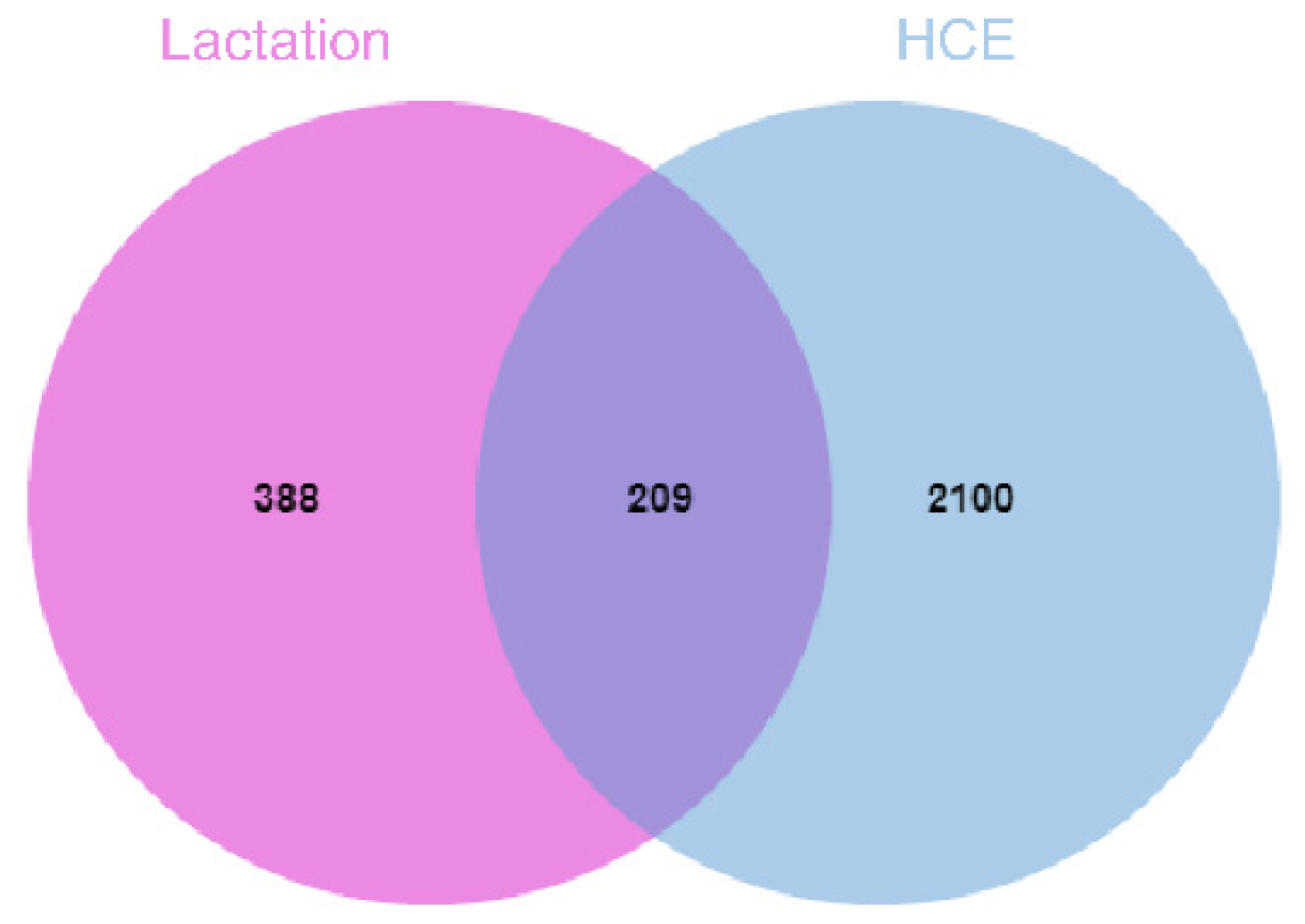
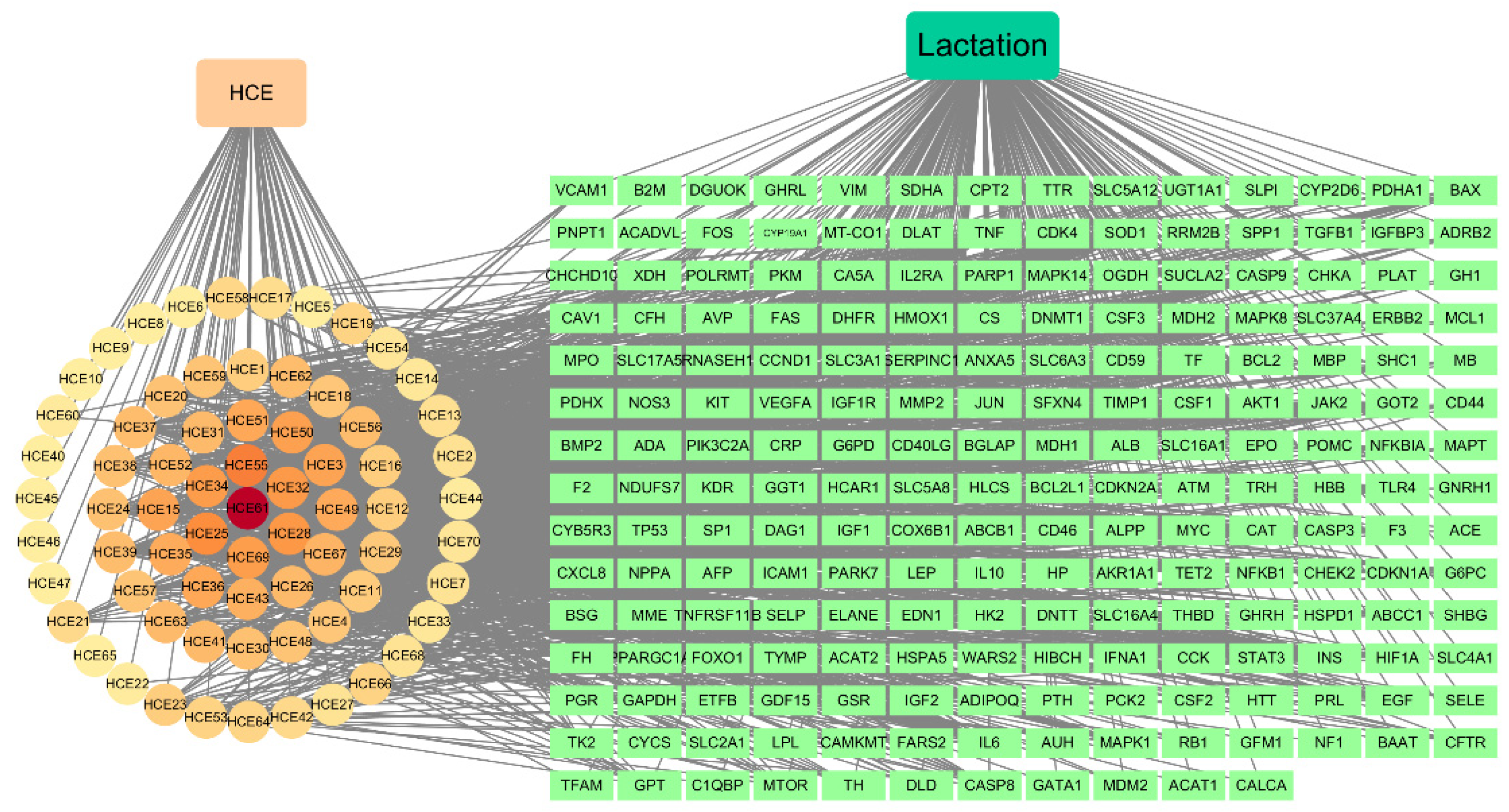
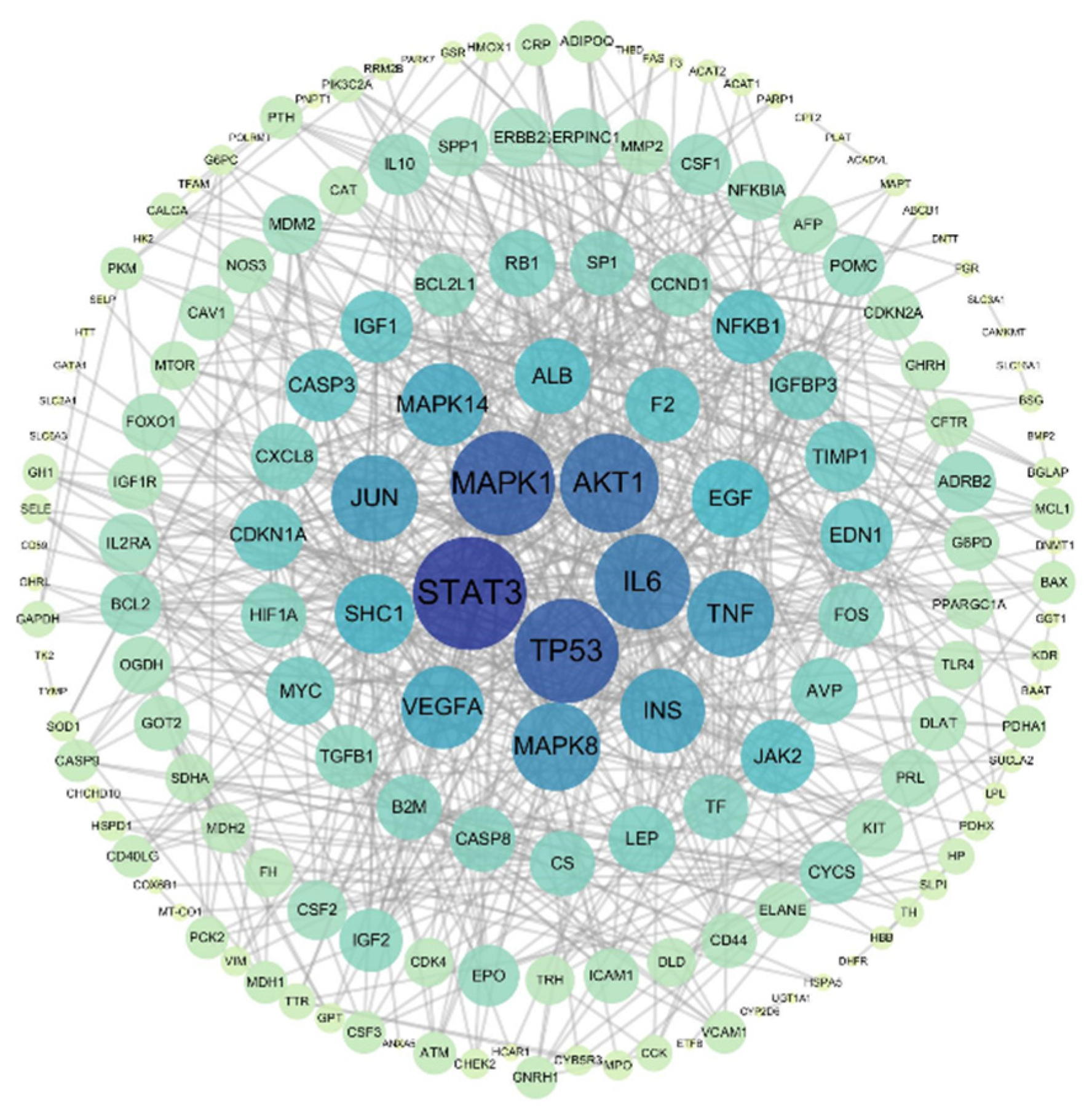
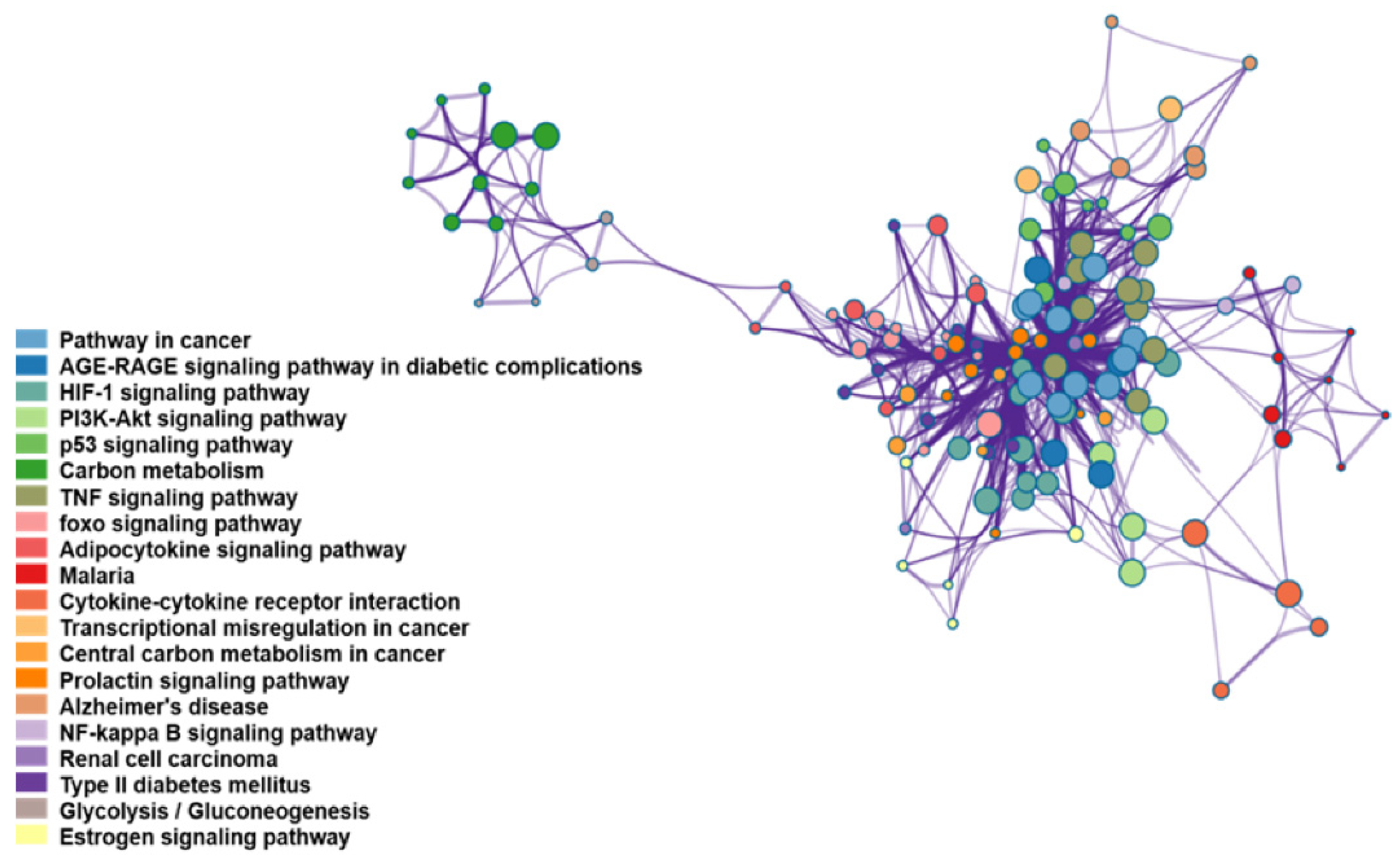
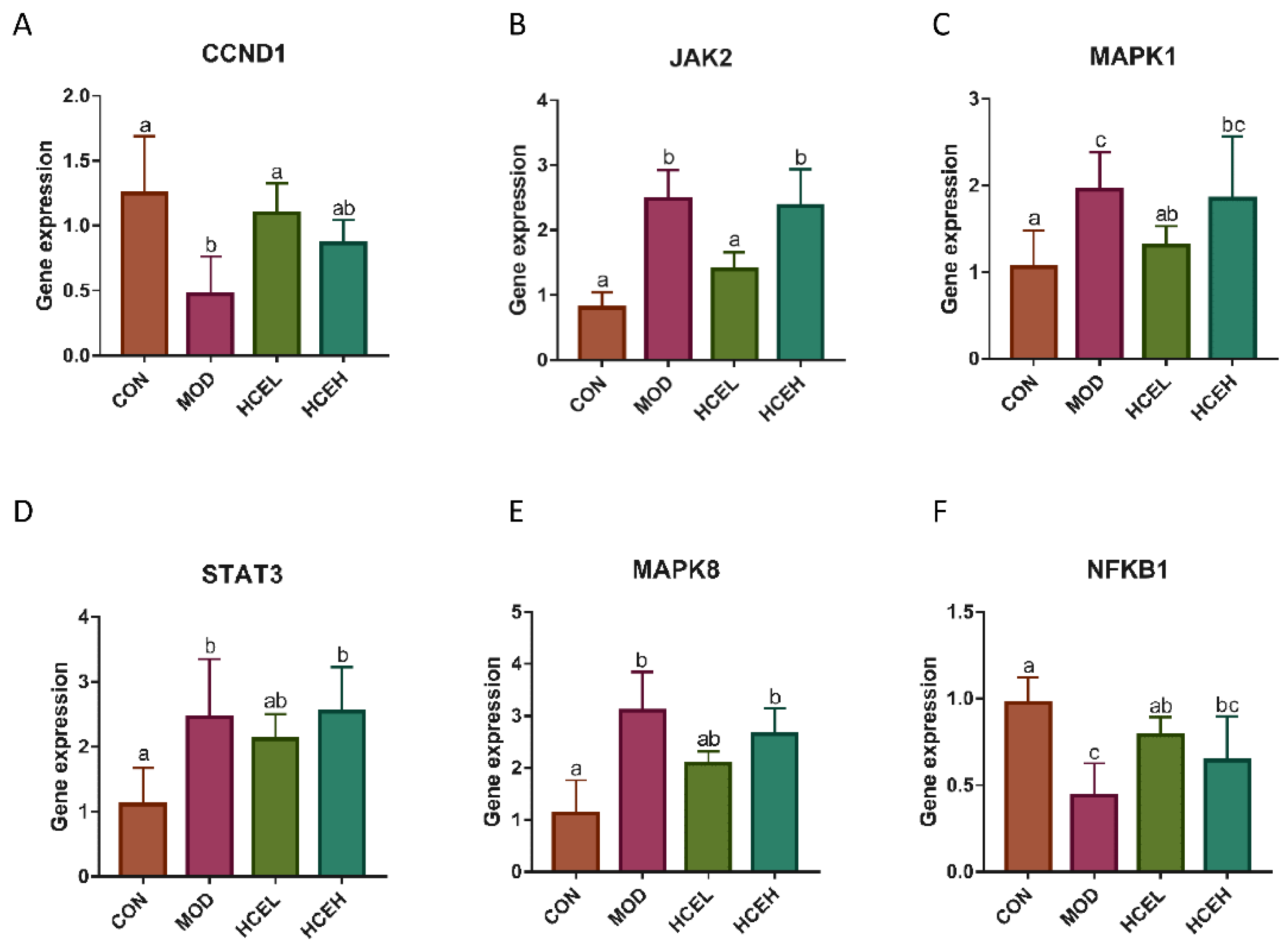
| No. | Name | Degree | Betweenness Centrality | Closeness Centrality |
|---|---|---|---|---|
| HCE61 | Quercetin | 95 | 0.09 | 0.49 |
| HCE55 | Kaempferol | 52 | 0.02 | 0.42 |
| HCE25 | Thymidine | 47 | 0.02 | 0.42 |
| HCE28 | Chlorogenic acid | 42 | 0.01 | 0.41 |
| HCE32 | Caffeic acid | 41 | 0.01 | 0.41 |
| HCE34 | Rutin | 40 | 0.01 | 0.41 |
Publisher’s Note: MDPI stays neutral with regard to jurisdictional claims in published maps and institutional affiliations. |
© 2021 by the authors. Licensee MDPI, Basel, Switzerland. This article is an open access article distributed under the terms and conditions of the Creative Commons Attribution (CC BY) license (https://creativecommons.org/licenses/by/4.0/).
Share and Cite
Zhong, J.; Liang, Y.; Chen, Y.; Zhang, J.; Zou, X.; Deng, J.; Wang, D.; Sun, Y.; Li, M. Study and Experimental Validation of the Functional Components and Mechanisms of Hemerocallis citrina Baroni in the Treatment of Lactation Deficiency. Foods 2021, 10, 1863. https://doi.org/10.3390/foods10081863
Zhong J, Liang Y, Chen Y, Zhang J, Zou X, Deng J, Wang D, Sun Y, Li M. Study and Experimental Validation of the Functional Components and Mechanisms of Hemerocallis citrina Baroni in the Treatment of Lactation Deficiency. Foods. 2021; 10(8):1863. https://doi.org/10.3390/foods10081863
Chicago/Turabian StyleZhong, Jing, Yuxuan Liang, Yongchun Chen, Jiawei Zhang, Xiaoying Zou, Jie Deng, Da Wang, Yuanming Sun, and Meiying Li. 2021. "Study and Experimental Validation of the Functional Components and Mechanisms of Hemerocallis citrina Baroni in the Treatment of Lactation Deficiency" Foods 10, no. 8: 1863. https://doi.org/10.3390/foods10081863
APA StyleZhong, J., Liang, Y., Chen, Y., Zhang, J., Zou, X., Deng, J., Wang, D., Sun, Y., & Li, M. (2021). Study and Experimental Validation of the Functional Components and Mechanisms of Hemerocallis citrina Baroni in the Treatment of Lactation Deficiency. Foods, 10(8), 1863. https://doi.org/10.3390/foods10081863




